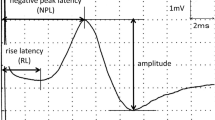Summary
The introduction in the 60' s of the Nerve Excitability Test (NET) by Laumans and Jongkees for the diagnosis of Bell's palsy stimulated an interest of quantitative testing of the facial nerve. In 1970 Yanagihara reported the Evoced Myography (EMG; i.e. NET is combined with EMG).
Starting with electrophysiological basis of the impulse spread of peripheral nerves May, in 1971, extended this concept by including supraliminal stimuli, i.e. Maximal Stimulation Test (MST), for diagnostic purposes.
This method eventually developed into what is known as neuronography (Esslen, Huffmann, Ehrenberger, Satoh). It is undoubtedly a refinement in the question of prognosis of Bell's palsy.
Continuing the original concept of May we have developed an electronic device with which to carry out automatically the neuronography that demonstrates an evaluation on a numeric display.
We use the conventional bipolar negative square wave for a 1 ms stimulation. We stimulate the angle of the mandible, where the ramus marginalis can be readily found in all patients.
Neuronography and Evoked Myography provide earlier a more precise prognosis of facial palsy than Nerve Excitability Test (NET). We developed an electronic device for the Maximal Stimulation Test (MST) of May, M., that is automatic. The device counts the spikes of the evoked myogram. A time window is related to the stimulus to exclude stimulus noise and background muscle noise from the counter. Only spikes seen in this window are processed. The number of spikes generated per stimulus is the measurement of the live axons in a stimulated nerve.
Zusammenfassung
Neuronografie und Evoked Myographie erlauben eine frühzeitigere Prognosestellung der idiopathischen Facialisparese als der Nerve Excitability Test (NET). Ausgehend von dem Maximal Stimulation Test (MST) von May, M., einer Weiterentwicklung des NET, wurde eine Apparatur konstruiert, die eine automatische numerische Auswertung des MST erlaubt. Das evozierte Myogramm wird elektronisch auf die vorhandenen Spikes abgetastet. Zur Unterdrückung von Reizeinbruch und Spontanaktivität wird ein Zeitfenster in Abhängigkeit von dem Reiz gebildet und nur die Spikes gezählt, die in diese Fenster fallen. Die Anzahl der Spikes pro Reiz ist ein Maß für den aktiven Faserquerschnitt des gereizten Nerven. Eine Axondegeneration wird frühzeitig an der abnehmenden Spikezahl erkennbar.
Similar content being viewed by others
References
Buchthal, F., Rosenfalck, P.: On the structure of motor units. New developments in electromyography and clinical neurophysiology (ed. J. E. Desmedt), vol. 1, pp. 71–85. Basel: Karger 1973
Bousset, S., Maton, B.: Comparison between surface and intramuscular EMG during voluntary movement. New developments in electromyography and clinical neurophysioiogy (ed. J. E. Desmedt), vol. 1, pp. 533–539. Basel: Karger 1973
Ehrenberger, K.: Die klinische Anwendung der Neuronografie bei Facialisparesen. Laryng. Rhinol. 54, 39–44 (1975)
Esslen, E.: Electrodiagnosis of facial palsy. In: Miehlke, A., Surgery of the facial nerve, II. ed., pp. 45–51, München 1973
Esslen, E.: Personal communication
Fujita, T.: Über die periphere Ausbreitung des N. facialis beim Menschen. Morph. Jb. 73, 578–614 (1934)
Huffmann, G., Giesen, R.: Elektromyografie und Elektroneuronografie bei peripheren Facialisiähmungen. Vortrag 43. Jahrestagung der Vereinigung Westdeutscher Hals-Nasen-Ohrenärzte, Köln, 4.–5. Okt. 1974. HNO 23, 197–201 (1975)
Kettel, K.: Peripheral facial palsy. Copenhagen: Munksgaard 1959
Laumans, E. P. J., Jonkes, L. B. W.: On the prognosis of peripheral facia paralysis of endotemporal origin. An. Otol. 72, 307–323, 621–636, 895–899 (1963)
Laumans, E. P. J.: Nerve excitability test in facial paralysis. Arch. Otolaryng. 81, 478–488 (1965)
May, M., Harvey, J. E., Stroud, M.: The prognostic accuracy of the maximal stimulation test compared with that of the nerve excitability test in Bell's palsy. Laryngoscope 81, 931–938 (1971)
Miehlke, A.: Surgery of the facial nerve, II. ed. München 1973
Satoh, I. Kumagami, H.: An evoced electromyographic test for peripheral facial palsy. ORL 37, 1–18 (1975)
Seiler, C.: Automatische Signalerkennung in der elektrophysiologischen Diagnostik. In Vorbereitung.
Yanagihara, N., Kishimoto, M.: Electrodiagnosis in facial palsy Arch. Otolaryng. 95, 376–382 (1972)
Author information
Authors and Affiliations
Rights and permissions
About this article
Cite this article
Seiler, C.F., Eitschberger, E. Automatic recording and evaluation of Neuronography. Arch Otorhinolaryngol 212, 127–131 (1976). https://doi.org/10.1007/BF00454272
Received:
Issue Date:
DOI: https://doi.org/10.1007/BF00454272




